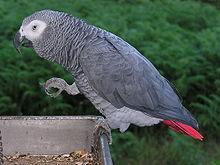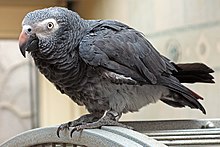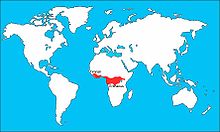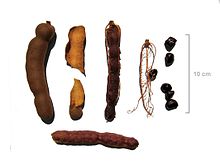African gray parrot
| African gray parrot | ||||||||||||
|---|---|---|---|---|---|---|---|---|---|---|---|---|
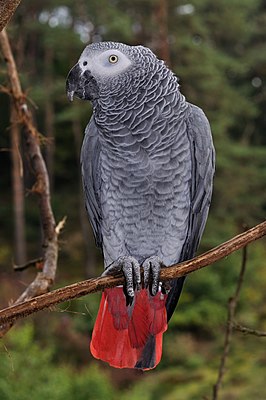
Congo African Gray Parrot ( Psittacus erithacus erithacus ) |
||||||||||||
| Systematics | ||||||||||||
|
||||||||||||
| Scientific name of the genus | ||||||||||||
| Psittacus | ||||||||||||
| Linnaeus , 1758 | ||||||||||||
| Scientific name of the species | ||||||||||||
| Psittacus erithacus | ||||||||||||
| Linnaeus , 1758 |
The African Gray Parrot ( Psittacus erithacus ) is a bird art from the family of authentics Parrots (Psittacidae). It is the only species in the genus Psittacus . With a body length of approx. 33 cm and a body weight of up to 450 g, it is one of the largest parrots in Africa .
African gray parrots are also often kept and bred in zoos and private households. Due to their high level of intelligence and language skills , they are one of the most important animal species in cognitive research . Reports and research on wild African gray parrots, however, are rarer. They appear in pictures by European artists after European seafarers first reached the African distribution area.
Subspecies, distribution
Description of the species and subspecies
Today a distinction is made between two forms of the African gray parrot. On the one hand the Congo gray parrot , which was described by Linné in 1758 as Psittacus erithacus and occurring in Gabon . Second, the 1844 Fraser after its place in Timneh County, Sierra Leone , as timneh Psittacus described Timneh Parrot . There are different views as to whether both forms should be treated as species or subspecies. The differentiation of a third subspecies ( P. e. Princeps ) from the islands of Príncipe and Bioko , whose representatives are said to be larger and darker than the Congo gray parrot of the mainland, is now considered questionable.
African gray parrots have a predominantly gray plumage, which gives them their name, the face is white and featherless around the eyes, the plumage on the head is lighter. The wax skin is white, the beak black, the iris yellow or white-yellow. Females are colored like males, often slightly smaller. Young animals have a slightly brown-gray plumage on the back and wings, as well as a different tail color. The iris changes color from black to dark gray, gray after 6–8 months to white-yellow. The nominate form has a bright red tail. The Timneh gray parrot is slightly smaller, its tail feathers are dirty wine-red, the upper bill is not black, but lighter brownish-pink and the plumage is darker gray. Depending on the area of origin, the Congo African gray parrot has differences in body size and color. Birds from Cameroon are colored darker gray than birds from the Congo.
Mutation breeding does not play a role in African gray parrots. The so-called gray king parrots , which have numerous red feathers on their bodies, and whose existence is a topic above all in shallow literature, with owners and breeders as well as in Internet forums, is probably due to a pathological or diet-related deviation in plumage color.
distribution
The African gray parrot lives in Central and West Africa and is a resident bird in its entire area . The distribution reflects the occurrence of tropical rainforests very precisely and extends somewhat into the area of the wet savannah at the area edges .
The Congo African gray parrot is distributed northward to southern Nigeria , Cameroon and the Central African Republic , to the east to western Kenya and northwestern Tanzania . The main areas of distribution are Gabon , the Republic of the Congo and the north and central parts of the Democratic Republic of the Congo . Western area outposts are located in southern Ghana and in the south-east of Côte d'Ivoire, as well as the “Príncipe Gray Parrot” on the islands of Bioko (Fernando Poo), São Tomé and Príncipe .
The Timneh gray parrot is found in the southwest of Côte d'Ivoire, Sierra Leone , Liberia and the southeast of Guinea .
habitat
The African gray parrot is a typical tree dweller. Its habitat includes tropical rainforests, mangroves and wet savannas. He likes to stay on the edge of the woods to the open landscape, visits cultivated land and gardens there , but avoids human settlements.
Way of life
nutrition
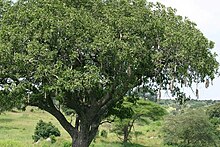
The African gray parrot prefers vegetarian foods such as fruits ( nuts , berries ), seeds , flowers and buds . They are to be seen as less specialized generalists. The main sources of food for parrots are fruits and parts of plants that grow on trees. African gray parrots are ideally adapted to life in the treetops because of their climbing foot and the beak used for climbing.
The plants they eat include: Elaeis guineensis (African oil palm ), Kigelia pinnata ( liver sausage tree ), Bombax sp., Ceiba sp., Dacryodes sp., Tamarind Tamarindus indica, Carica papaya ( papaya ), Harungana sp., Combretum sp. (bushwillow), Terminalis sp., Macaranga sp., Heisteria sp., Parkia sp., Ficus sp., also Ficus sykomorus and Ficus sur , Musa sp. ( Bananas ), millet , Zea mays ( maize ), Raphia sp., Prunus africana (African Almond), Prunus sp., Akeeplaume Blighia sapida, Cola tragacantha, Celtis sp. ( Hackberry ). The main food crops presumably differ regionally and seasonally according to the supply, different observers indicate different preferences, which is already clear in the older literature. Alien species such as bananas or maize can also be found among the food crops, which speaks for the adaptability of the African gray parrots.
For a subpopulation of African gray parrots, the ingestion of soil or clay is believed to be used to absorb minerals or to detoxify food in the digestive tract.
Voice in the field
In the wild, African gray parrots communicate with shrieks and high-pitched whistles. They often fly at great heights and communicate loudly with one another.
Daily routine and social structure
The shy birds stay in pairs or in small groups during the day. In the twilight they often come together to form larger swarms.
Reproduction
African gray parrots are believed to be paired for life. They breed outside of the rainiest season. The breeding season changes from region to region depending on the location of the rainy season . The birds breed in tree hollows, often in large dead trees. The nest cavity is padded with mildew wood. The female lays 2-5 eggs and incubates them for about 4 weeks while the male guards and feeds her. The young birds, which both parents take care of, take almost 3 months to fledge.
A couple's reproductive performance in captivity can be very high. From 1962 to 1974, 87 young birds were reared by hand in the United States by a single pair . This corresponds to 7.25 young animals per year. The rate of reproduction in the wild is certainly lower.
Natural enemies
The natural enemies include birds of prey , protective behavior is triggered against flying black- axled eagles ( Cassinaëtus africanus ), but not by palm vultures ( Gypohierax angolensis ), although they have been observed during successful hunting of the awkwardly flying African gray parrots. Even hawks hunt gray parrots. Nests are often robbed by monkeys and snakes .
Endangerment and species protection
Catching and trading are a particular threat. The IUCN assumes that stocks are in decline. Since 2016 she has classified the species as "endangered". The causes of the decline of the species include the catch for the international bird trade and the increasing loss of habitat .
Since 1981 the species has been covered by the Washington Convention on the Protection of Species (CITES, German WA) and since 1987 it has been specially protected under European law. Since February 4, 2017, it has been listed in Annex A of Regulation (EC) No. 338/97 ( EU Species Protection Regulation ) and thus enjoys the highest protection status in the European Union. Therefore, any import into the EU and any marketing in the EU is prohibited without formal approval from the competent authority ; in Germany this is a criminal offense; this applies to living specimens as well as to parts from animals of this type or to eggs.
attitude


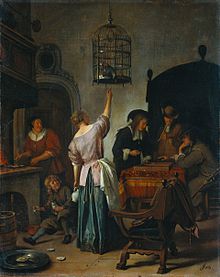
History of the attitude in Europe
It is questionable whether African gray parrots were known in ancient Europe, as there is no evidence for this. For the first time, the news of African gray parrots reached Europe when Portuguese sailors found the Canary Islands - where African gray parrots are supposed to have been - after 1400 or the natural African range of parrots around 1455, although the range was reached before that of the neotropical parrots they only appear on paintings from around 1525. The Neotropical parrots are depicted much earlier. Dürer drew the first Amazon in 1498, just six years after America was discovered. Conrad Gessner's animal book clearly mentions a gray parrot in its 1555 edition. At the beginning of the 17th century, African gray parrots were well known as they were brought to Europe alive by seafarers. Also Eleazar Albin published 1731-1738 'Natural history of Birds' includes a color illustration of the gray parrots. The partially very lifelike images on paintings, engravings or watercolors from this period show that African gray parrots were also kept more often in private hands and could therefore be known to the artists firsthand. But the more colorful parrot species, especially from Asia and America, dominate paintings.
Gray parrots are one of the few parrot species that Linne names in the 10th edition of his Systema Naturae from 1758 and are the only parrot species that still bears the original Linnaeus genus name today.
Two broods that took place in France in 1799 are considered the world's first breeding. Further national first breeding took place in England in 1843, in Germany in 1899, in the USA in 1931, and in Sweden in 1953. In the case of Timneh gray parrots, the dates of the first breeding are later. The transition from accidental breeding to regular breeding in captivity took place in the second half of the 20th century. Breeding is no longer a problem. They are propagated in such large numbers in private hands and by commercial breeders that the demand no longer has to be met from the field. The gray parrot is one of the most frequently kept and best-known parrot species today , apart from budgies .
Modern attitude
African gray parrots are kept mainly for their intelligence and language skills. The intelligent birds can react extremely sensitively to changes or the loss of partner birds or caregivers. Plucking can result from such changes.
If African gray parrots are to be kept according to modern zoo biological concepts, group or at least paired keeping is necessary. According to these ideas, the individual keeping in the apartment, which has long been practiced as the normal form of keeping, is criticized as not being appropriate to the species, as is the clipping of the wings to enable keeping on a parrot tree outdoors.
In 1995 published expert opinion on minimum requirements for keeping parrots , an aviary size of at least 2 × 1 × 1 m (width × depth × height) is given for a gray parrot as a guide, for the second bird half the area is to be added.
In order to limit the endangerment of free-range stocks, species protection laws are to be observed when buying and importing and animals from offspring are to be preferred. The super-tame hand-rearing that are often offered on the market are problematic from a zoo-biological point of view; massive problems can arise when the animals reach sexual maturity. A market for advising pet owners has developed here.
The feeding and occupation of the animals in captivity is not a problem today.
For every legal animal in the European Union there is a so-called CITES certificate, i.e. a formal official document regarding the exception to the import and purchase bans. In Germany, every posture and change in the regular location of a specimen must be reported immediately to the local nature conservation authority, including stating its identification, i.e. regularly with the individual ring number .
The import of wild birds into the EU is currently prohibited due to avian flu prophylaxis.
Tool use
In the case of African gray parrots, tool use has been documented in human care. For example, twigs can be used to clean the plumage. Hollow objects can be used to absorb water. Tools can also be used for digging.
Maximum age in captivity
Information on the average and maximum ages of wild gray parrots is not available. In human care the species can live up to 60 years. As an extreme case, an age of 73 years has been proven.
Known African gray parrots
Individual African gray parrots have achieved worldwide fame. The African gray parrot Alex (1976 to 2007), which belonged to the scientist Irene Pepperberg , became particularly well known . Pepperberg used him to study the cognitive abilities of African gray parrots, especially their ability not only to imitate human speech, but to use words in a meaningful context. Among other things, Alex learned to correctly designate 50 objects presented to him using a special sound utterance, plus seven colors and five shapes. According to Pepperberg, he could also make simple additions and designate non-existent objects as non-existent, which she describes as a "zero-like concept" (in German, for example: a name that is similar to the term zero). The researcher herself admits, however, that nonexistent and zero are by no means synonymous with each other. Alex's abilities have not been matched by any other parrot in her group.
Joseph Haydn's African Gray Parrot was able to whistle along with several of the melodies that Haydn composed. At parties in Haydn's house in the Viennese suburb of Windmühle , when a toast was pronounced to the emperor and the glass was raised, he is said to have whistled the melody to God preserve Franz the emperor . After the composer's death the bird was finally for the enormous price of 1,415 guilders - today about 32,500 equivalent to Euro - auctioned .
literature
- Louis Fraser: Description of three New Species of Birds. In: Proceedings of the Zoological Society of London. Volume 12, 1844, pp. 37-38 ( online ).
- Wolfgang de Grahl: The African gray parrot. A chronicle from 100 years. Self-published 1976, ISBN 3-9800108-0-5 .
- Carl R. Hennicke. The African gray parrot in freedom and in captivity. (= Ornithological writings. No. 1.) Verlag von EM Köhler, Gera 1895 ( online ).
- Richard Howard & Alick Moore: A Complete Checklist of the Birds of the World. 2nd, revised edition. Academic Press, London 1994, ISBN 0-12-356910-9 .
- MJ Janzen, DH Janzen & CM Pond: Tool-using by the African Gray Parrot (Psittacus erithacus). In: Biotropica. Volume 8, 1976, p. 70.
- Tony Juniper & Mike Parr: Parrots. A guide to parrots of the world. Yale University Press, New Haven / London 1998, ISBN 0-300-07453-0 .
- Lars Lepperhoff: The gray parrot in Africa and in human care. Part 1. In: Parrots. No. 6, 2005. The African gray parrot and in captivity. Part 2. In: Parrots. No. 7, 2005.
- Diana Lynn May: Gray Parrots of the Congo Basin Forest. In: PsittaScene. Volume 13, No. 2, 2001, Ser. No. 47, pp. 8-10 ( PDF file; 2.5 MB ).
- Diana Lynn May: Wild gray parrots in the Congo Basin. Part 1. In: Parrots. No. 9, 2002. Wild gray parrots in the Congo Basin. Part 2. In: Parrots. No. 10, 2002.
- Diana Lynn May: The Vocal Repertoire of Gray Parrots (Psittacus erithacus) Living in the Congo Basin. Dissertation, The University of Arizona 2004 ( online ).
- Anastasia Ngenyi: African Gray Parrot Trade in Cameroon. In: PsittaScene. Volume 14, No. 2, 2002, Ser. No. 51, pp. 2–3 ( PDF file; 2.5 MB ). See also: African gray parrot trade. Translation from English by Franziska Vogel. ( MS Word file; 152 kB ).
- Irene M. Pepperberg: Alex and me. The unique friendship between a Harvard researcher and the smartest bird in the world. MVG Verlag, Munich 2009, ISBN 978-3-86882-026-3 .
- Anton Reichenow: The birds of Africa. Volume 2. Verlag von J. Neumann, Neudamm 1902–1903, pp. 2-6 ( online ).
- Karl Russ: The African gray parrot. Its natural history, care and training. Creutz'sche Verlagsbuchhandlung, Magdeburg 1896 ( online ).
- Rachel Schmid: The influence of the breeding method on the behavior of adult African gray parrots. Dissertation, Bern 2004 ( PDF file ).
Web links
- Diana L. May, Field Studies of African Gray Parrots in the Central African Republic http://www.funnyfarmexotics.com/IAS/greyfield.htm ( Memento from May 1, 2009 in the Internet Archive )
- Psittacus erithacus inthe IUCN Red List of Threatened Species 2011.2. Listed by: BirdLife International, 2008. Retrieved January 3, 2012.
- BirdLife International: Species Factsheet - Gray Parrot ( Psittacus erithacus ) . Retrieved January 3, 2012.
- Videos, photos and sound recordings of Psittacus erithacus in the Internet Bird Collection
- African gray parrot ( Psittacus erithacus ) at Avibase; Retrieved January 3, 2012.
- Psittacus erithacus in the Integrated Taxonomic Information System (ITIS). Retrieved January 4, 2012.
- xeno-canto: Sound recordings - Gray Parrot ( Psittacus erithacus )
Individual evidence
- ↑ Size information: Lantermann, W. (1999): Parrot Studies. Berlin; Robiller, F. (1997): Parrots Vol. 2. Walsrode; Juniper, T. / Parr, M. (1998): Parrots. London - New Haven
- ^ Carl von Linné: Systema Naturae. Tomus I. 10th edition. Stockholm 1758, p. 99.
- ^ Fraser (1844), Proceedings of the Zoological Society of London. Volume 12, 1844, p. 38
- ↑ Howard & Moore (1994), p. 105, and Juniper & Parr (1998), p. 376, treat both forms as subspecies.
- ↑ First description with species status by Boyd Alexander (1909) from Principe Island: Boyd Alexander: Description of a new species of Gray Parrot (Psittacus princeps) from Princes Island, W. Africa. In: Bulletin of the British Ornithologist's Club. Volume 23, 1909, p. 74 ( online ).
- ↑ Juniper & Parr, M. (1998), p. 376.
- ↑ a b Wolfgang de Grahl (1990): Parrots in the house and garden. Stuttgart. P. 124
- ↑ http://www.vogelforen.de/archive/index.php/t-17542.html http://www.papageientreff.org/showthread.php?t=7214&highlight=K%F6nigsgraupapagei
- ↑ a b c May in Parrotien 9/2002
- ↑ Compilation of food plants from: Juniper, T. / Parr, M. (1998): Parrots. London - New Haven; Reichenow (1902-1903); Fry, HC & Keith, S. & Urban, EK (1988): Birds of Africa. London Academic Press
- ↑ Compilation of observations e.g. B. in Reichenow (1902–1903)
- ↑ Lantermann: Parrot Studies p. 440
- ↑ Reichenow (1902–1903), p. 4
- ↑ Reichenow (1902–1903), p. 5
- ^ IUCN Red List: "Psittacus erithacus" 2016 ( HTML file ); Anastasia Ngenyi: African Gray Parrot Trade in Cameroon. In: PsittaScene. Volume 14, No. 2, 2002, serial No. 51, pp. 2-3. ( PDF file; 2.5 MB ) See also: African gray parrot trade. Translation from English by Franziska Vogel. ( MS Word file; 152 kB ); Abiodun Raufu (2000): Smugglers are catching Nigeria's threatened African gray parrots to the brink of extinction. ( HTML file ); Itayi Viriri (2000): SPCA accuses the Zimbabwe army of parrot smuggling.
- ↑ Research on the WISIA portal of the German Federal Agency for Nature Conservation
- ↑ Art. 4 Paragraph 1 (Import) and Art. 8 Paragraph 1 (Marketing) Regulation (EC) No. 338/97
- ↑ "strictly protected" according to §7 para. 2 no. 14 Federal Nature Conservation Act ; Offense according to §71 para. 1 no. 3 (import) or Section 71 (2) (marketing) of the Federal Nature Conservation Act
- ↑ a b c Strunden, H. (1984): Parrots once and now. Bromlitz
- ↑ Examples are: Francesco Melzi : Portrait of Man with a Parrot ca.1525, Lucas Cranach the Elder : Albrecht of Hohenzollern as St. Jerome in his study from 1526
- ↑ Strunden, H. (1984): Parrots then and now. Bromlitz p. 36 fig.
- ↑ Hans-Jürgen Pfeffer: Conrad Gesner and the parrots
- ↑ Strunden, H. (1984): Parrots then and now. Bromlitz Strunden names William Derham as the author , but Eleazar Albin is correct. Table 12 illustration is meant
- ↑ Robillier, F. (1997): Parrots Vol. 2. Walsrode
- ↑ Minimum requirements for keeping parrots (January 10, 1995)
- ↑ Example: http://www.papageien-training.de
- ↑ Article 4 - 10 EU species protection regulation
- ↑ § 7 Federal Species Protection Ordinance
- ↑ Boswall in Lantermann, 1999
- ↑ Wolfgang de Grahl: Parrots in the house and garden. Stuttgart 1990, p. 126
- ↑ Süddeutsche Zeitung No. 210 of September 12, 2007, p. 18
- ↑ Clear round for Alex. The African gray parrot knows the meaning of "zero" despite its walnut-sized brain. On: Wissenschaft.de from July 12, 2005.
- ↑ Rainer Schmitz, Benno Ure: Keys, tones and tumults: Everything you don't know about music . Siedler, Munich 2016, ISBN 978-3-8275-0083-0 , p. 720 .
